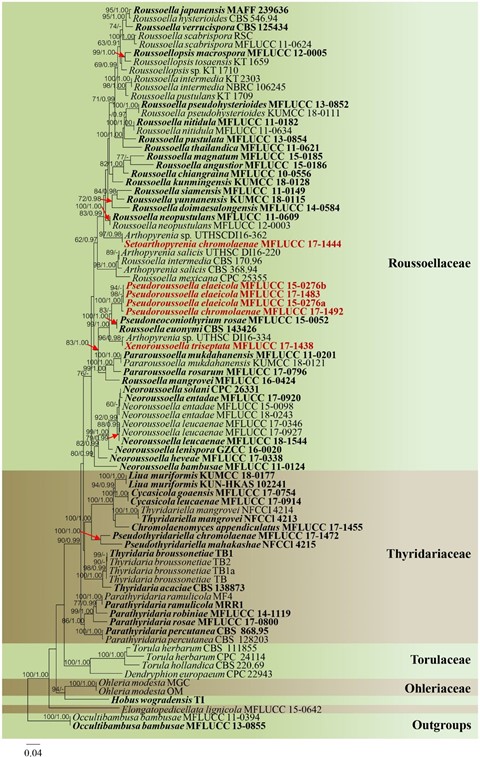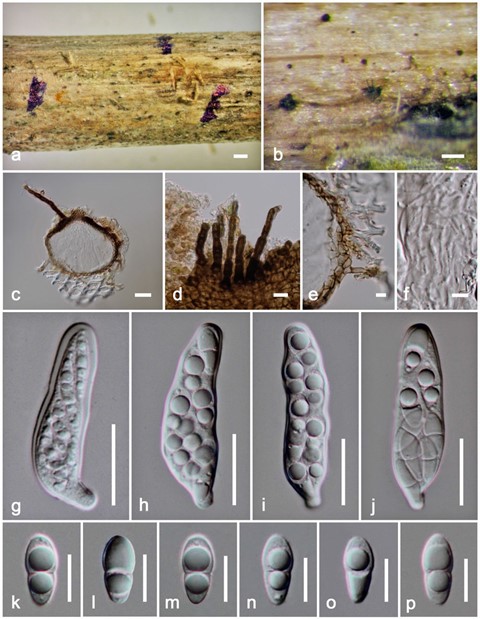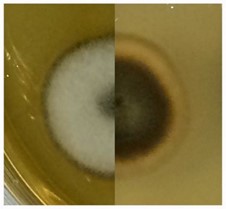Setoarthopyrenia chromolaenae Mapook & K.D. Hyde, sp. nov.
MycoBank number: MB 557362; Index Fungorum number: IF 557362; Facesoffungi number: FoF 07821; Fig. 80
Etymology: Name reflects the host genus Chromolaena, from which this species was isolated.
Holotype: MFLU 20-0368
Saprobic on dead stems of Chromolaena odorata. Sexual morph: Ascomata 65–105 µm high × 80–95 µm diam. (x̅ = 85 × 88 µm, n = 5), superficial, solitary, appearing as small spots, coriaceous, globose, brown to dark brown. Ostiolar neck protruding, with numerous external brown to dark brown setae. Peridium (4.5–)5–10 µm wide, 2–3 layers, comprising brown to dark brown cells of textura angularis. Hamathecium comprising 0.5–1.5 µm wide, filiform to broadly filiform, septate, branching pseudoparaphyses. Asci 40–60 × 12–15 µm (x̅ = 55 × 13.5 µm, n = 10), 8-spored, bitunicate, cylindric-clavate, straight or slightly curved, apically rounded, short pedicellate. Ascospores 14–17 × 6–8 µm (x̅ = 15 × 7 µm, n = 25), bi-seriate, hyaline, ellipsoid to obo- void, 1-septate, guttulate, constricted at the septum, straight, without gelatinous sheath. Asexual morph: Undetermined. Culture characteristics: Ascospores germinating on MEA within 24 h. at room temperature and germ tubes produced from both ends. Colonies on MEA circular, mycelium slightly raised, entire, cultures white, olivaceous-brown at margin on surface, dark brown to olivaceous-brown from the centre of the colony in reverse with creamy-white appearing as concentric ring pattern and dark brown to olivaceous- brown at margin (Fig. 81).
Pre-screening for antimicrobial activity: Setoarthopyrenia chromolaenae (MFLUCC 17-1444) showed antimicrobial activity against B. subtilis with a 16 mm inhibition zone, when compared to the positive control (26 mm), but no inhibition of M. plumbeus and E. coli.
Material examined: THAILAND, Chiang Rai Province, Doi Pui, on dead stems of Chromolaena odorata, 5 August 2015, A. Mapook (DP37, MFLU 20-0368, holotype); ex- type culture MFLUCC 17-1444.
GenBank numbers: LSU: MT214438, ITS: MT214344, SSU: MT214392, TEF1: MT235768, RPB2: MT235805
Notes: In a BLASTn search of NCBI GenBank, the closest match of the ITS, LSU, TEF1 and RPB2 sequences of Setoarthopyrenia chromolaenae (MFLUCC 17-1444, ex- holotype) with 99.83% (LT796905), 100% (LN907505), 99.78% (LT797145) and 96.35% (LT797065) similarity, respectively, was Arthopyrenia sp. strain UTHSC: DI16-362, while the closest match of the SSU sequence with 99.81% similarity was Roussoella intermedia (strain CBS 170.96, KF443390). In the present phylogenetic analysis, S. chromolaenae (MFLUCC 17-1444) is closely related to Arthopyrenia sp. UTHSC: DI16-362 (Fig. 76). However, we could not compare the morphological characteristics of both strains as the morphology of Arthopyrenia sp. (UTHSC: DI16-362) has not been reported. Therefore, we introduce a new species based on morphology and phylogeny.

Fig. 76 Phylogram generated from maximum likelihood analysis based on combined dataset of LSU, ITS, TEF1, RPB2 and SSU sequence data. Eighty- four strains are included in the combined sequence analysis, which comprise 4416 characters with gaps. Tree topology of the ML analysis was similar to the BYPP. The best scoring RAxML tree with a final likelihood value of − 35074.673502 is presented. The matrix had 1690 distinct alignment pat- terns, with 39.45% of undetermined characters or gaps. Estimated base frequencies were as follows: A = 0.246392, C = 0.254324, G = 0.268438, T = 0.230846; substitution rates: AC = 1.657341, AG = 4.989387, AT = 2.205689, CG = 1.285998, CT = 10.615734, GT = 1.000000; gamma distribution shape parameter α = 0.486933. Bootstrap sup- port values for ML equal to or greater than 60% and BYPP equal to or greater than 0.90 are given above or below the nodes. Newly generated sequences and new combination are in dark red bold and type species are in bold. Occultibambusa bambusae (MFLUCC 11-0394) and O. bambusae (MFLUCC 13-0855) are used as outgroup taxa

Fig. 80 Setoarthopyrenia chromolaenae (holotype) a, b Appearance of superficial ascomata on substrate. c Section through ascoma. d dark brown setae. e Peridium. f Pseudo- paraphyses. g–j Immature and mature asci. k–p Ascospores. Scale bars: a = 500 µm, b = 100 µm, c, g–j = 20 µm, d, k–p = 10 µm, e, f = 5 µm

Fig. 81 Culture characteristic on MEA: Setoarthopyrenia chromolaenae (MFLUCC 17-1444)
